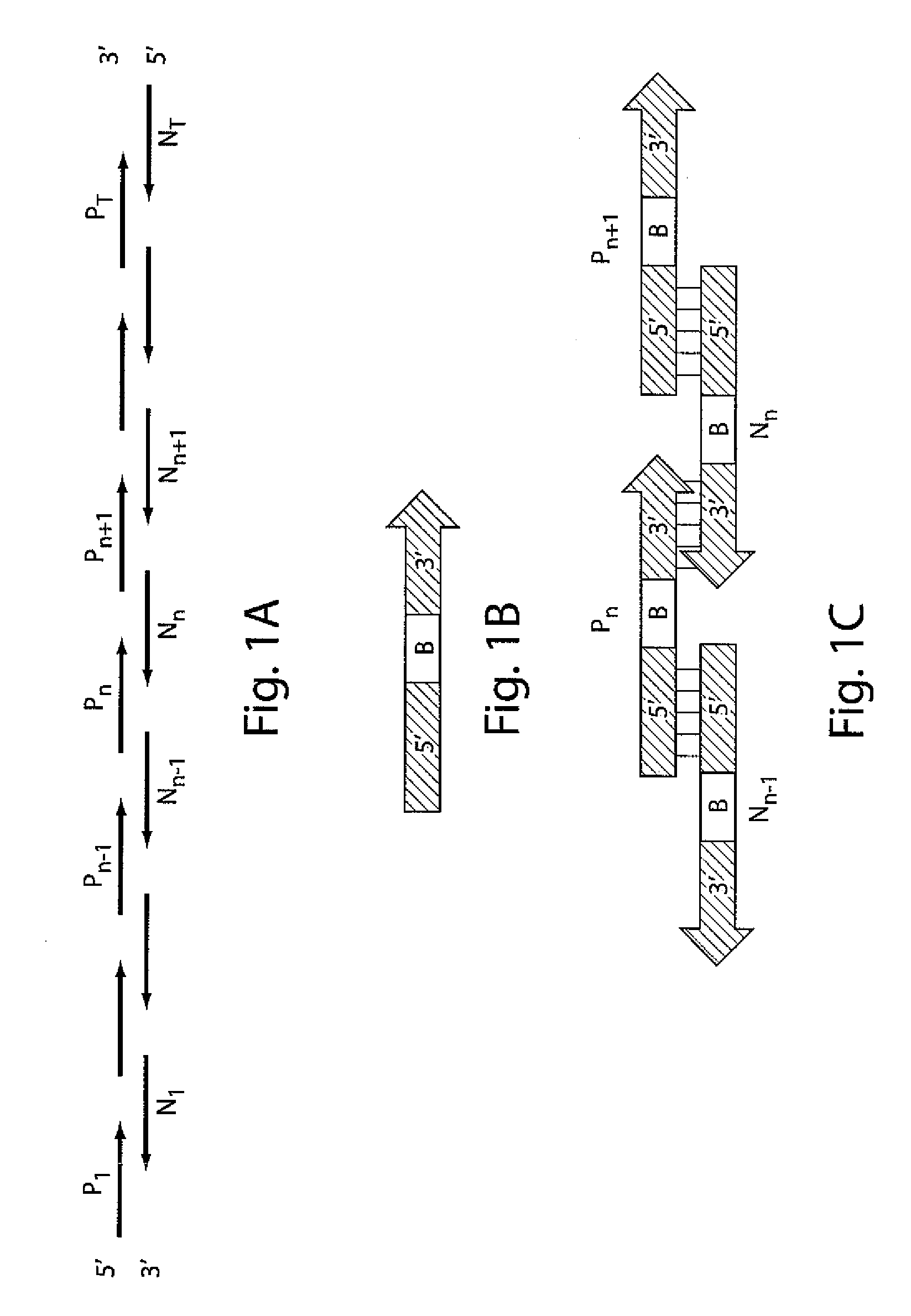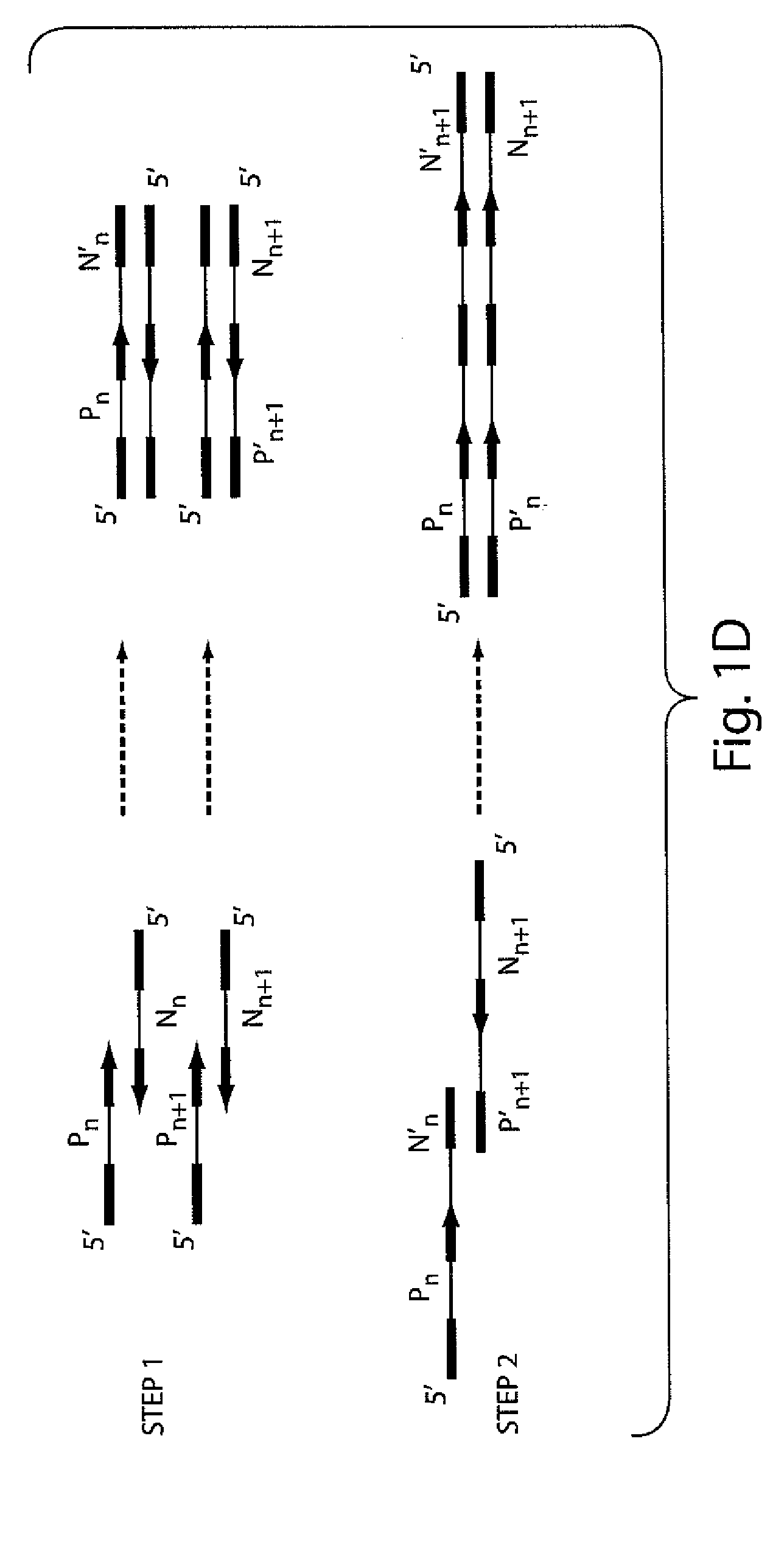Iterative nucleic acid assembly using activation of vector-encoded traits
a nucleic acid and vector-encoded technology, applied in the field of nucleic acid assembly methods, can solve the problems of slow and laborious iterative pairwise ligation of dna segments separated based on size, and achieve the effect of reducing the time required for nucleic acid assembly
- Summary
- Abstract
- Description
- Claims
- Application Information
AI Technical Summary
Benefits of technology
Problems solved by technology
Method used
Image
Examples
example 1
Nucleic Acid Fragment Assembly
[0212]Gene assembly via a 2-step PCR method: In step (1), a primerless assembly of oligonucleotides is performed and in step (2) an assembled nucleic acid fragment is amplified in a primer-based amplification.
[0213]A 993 base long promoter>EGFP construct was assembled from 50-mer abutting oligonucleotides using a 2-step PCR assembly.
[0214]Mixed oligonucleotide pools were prepared as follows: 36 overlapping 50-mer oligonucleotides and two 5′ terminal 59-mers were separated into 4 pools, each corresponding to overlapping 200-300 nucleotide segments of the final construct. The total oligonucleotide concentration in each pool was 5 μM.
[0215]A primerless PCR extension reaction was used to stitch (assemble) overlapping oligonucleotides in each pool. The PCR extension reaction mixture was as follows:
[0216]
oligonucleotide pool (5 μM total)1.0 μl (~25 nM final each)dNTP (10 mM each)0.5 μl (250 μM final each)Pfu buffer (10x)2.0 μlPfu polymerase (2.5 U / μl)0.5 μldH...
example 2
General Protocol
[0239]In this example, an assembly cycle using activation of one or more vector-encoded traits to isolate correctly assembled constructs will involve the following steps.[0240]1—DNA preparation;[0241]2—Digestion of insert DNA (e.g., at alternating sites 1, 3 and 2, 4 as described for FIGS. 6-8);[0242]3—Paired ligation of 1-3 cut fragments with 2-4 cut fragments together with vector DNA;[0243]4—Transformation of host cells with ligation reaction mixture;[0244]5—Recovery growth of the transformed cells in SOC (1-2h); and[0245]6—Transfer of the transformed cell culture to selective liquid media for growth in suspension (10-15 h).
[0246]This protocol selects for correctly-ligated insert DNA to propagate, removing any background or contaminating vector DNA. This enables an automated, ‘hands-off’ assembly scheme that eliminates colony grow-up during the assembly phase. This process may involve approximately log2N assembly steps where N is the total number of fragments to be...
example 3
[0249]In this example of an automated assembly scheme, the following steps will be automated.[0250]1—Transfer of enzyme mix (1, 3 or 2, 4) to prepped DNA;[0251]2-Temperature-controlled incubation for digest followed by heat inactivation (e.g., on a block);[0252]3—Mixing of 1, 3 and 2, 4 digests;[0253]4—Transfer of 1, 4-linearized vector and ligase to digest mix;[0254]5—Cell transformation;[0255]6—Suspension growth in selective media; and[0256]7—Automated DNA prep (e.g., CosMC prep on Biomek FX).
[0257]One or more of these steps may be automated on a microfluidic device.
PUM
| Property | Measurement | Unit |
|---|---|---|
| melting temperatures | aaaaa | aaaaa |
| concentration | aaaaa | aaaaa |
| antibiotic resistance | aaaaa | aaaaa |
Abstract
Description
Claims
Application Information
 Login to View More
Login to View More - R&D
- Intellectual Property
- Life Sciences
- Materials
- Tech Scout
- Unparalleled Data Quality
- Higher Quality Content
- 60% Fewer Hallucinations
Browse by: Latest US Patents, China's latest patents, Technical Efficacy Thesaurus, Application Domain, Technology Topic, Popular Technical Reports.
© 2025 PatSnap. All rights reserved.Legal|Privacy policy|Modern Slavery Act Transparency Statement|Sitemap|About US| Contact US: help@patsnap.com



